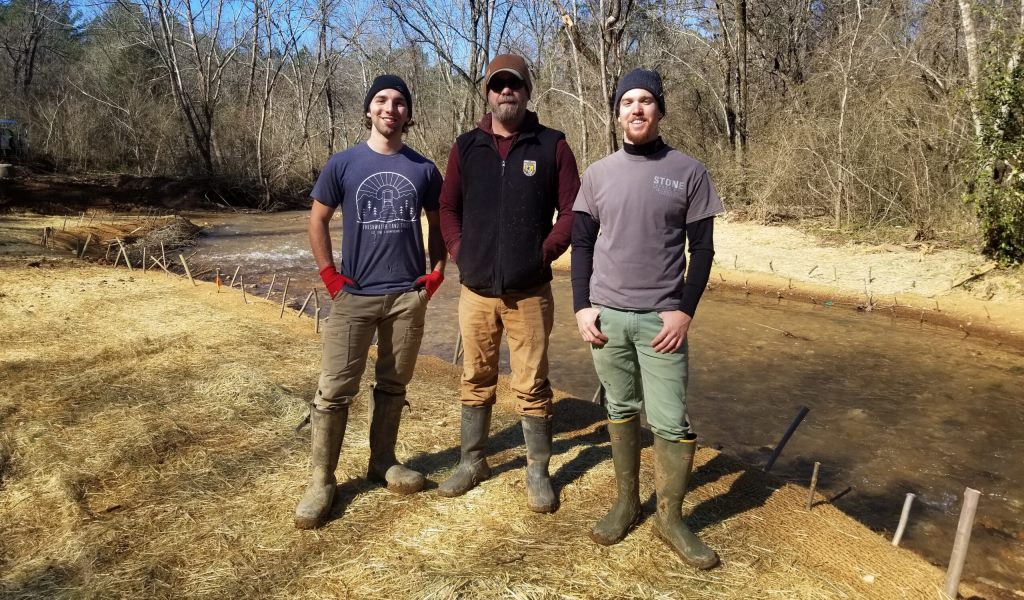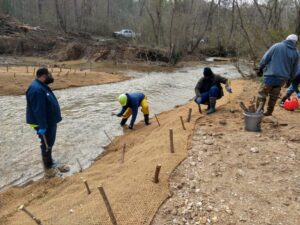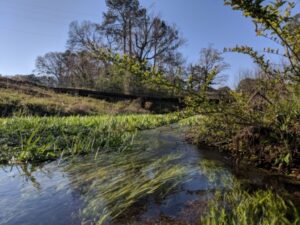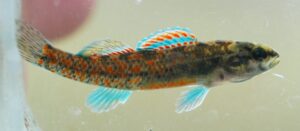One of the joys of having been deeply involved in the global restoration economy for over a quarter of a century (I started writing The Restoration Economy in 1996) is discovering yet another wonderful organization that’s busy regenerating our world.
The U.S. Environmental Protection Agency had just launched their brilliant national brownfields program the year before (in 1995), and I (Storm Cunningham) was one of the first 200 members of the newly-formed Society For Ecological Restoration. I keynoted their international conference in Belgium a decade or so ago.
But there were tons of local organizations that slipped under my radar at the time. For instance, that same year (1996) saw the creation of the Freshwater Land Trust (FLT), which restores, conserves, connects, and cares for land and water in Central Alabama, creating dynamic green spaces like trails for future generations. As you’ll see below, some their wonderful work is done in partnership with another local non-profit, Black Warrior Riverkeeper.
FLT works in Bibb, Blount, Dallas, Jefferson, Shelby, St. Clair, Tuscaloosa, and Walker counties, partnering with governments, corporations, landowners, and community groups. They are nationally accredited by the Land Trust Accreditation Commission, meeting national standards of excellence, upholding the public trust, and ensuring restoration and conservation efforts are permanent.
Here are just two examples of their work:
Turkey Creek
In February of 2022, Freshwater Land Trust collaborated with partners to complete a bank stabilization and in-stream restoration project in Jefferson County‘s Turkey Creek to benefit endangered vermilion darter (Etheostoma chermocki) habitat.
The Nature Conservancy in Alabama gave $15,000 (a sub-award from a National Fish and Wildlife Foundation grant) and Jefferson County Commissioner Joe Knight donated $10,000 to cover the project design by Wilbanks Engineering & Environmental Solutions, LLC.
U.S. Fish & Wildlife Service’s Partners for Fish & Wildlife gave about $20,000 for the materials, and Jefferson County Environmental Services Department supplied the equipment and donated nearly $40,000 worth of labor.
“Erosion and accretion are sometimes disruptive of the flow of our waterways,” said Knight. “We appreciate all involved who assisted in this effort.”
The project, which took place on FLT private property in Pinson along a Jefferson County sewer right-of-way, entailed reconstructing two Turkey Creek stream banks to address significant erosion issues.
Work took place at two locations within 200 feet of each other. The first location had the most significant work to be done, as the stream had rerouted about 50 feet away from the original creek channel.
“Erosion at this scale adds an unnatural amount of sediment into the water, which is detrimental for the species living in Turkey Creek, especially federally protected species,” said Sam McCoy, FLT’s Land Stewardship Director. “The completion of this project means there will be significantly less erosion and less sediment entering the creek.”
Jefferson County Environmental Services workers rerouted the stream back to the original channel, reshaped the banks to have gradual slopes, and strategically placed vegetative debris in the creek and its banks to serve as a buffer to slow the water’s velocity.
“The measures taken to slow the creek’s flow facilitate better overall habitat and lessen the erosive force of the water,” said McCoy.
Workers performed a similar treatment at the second site but did not need to reroute the stream. They planted live stakes and rye grass along the newly shaped banks at both locations, and a native seed mix will be planted later this spring after the final frost date.
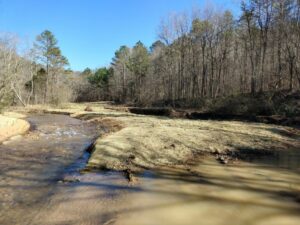 The majority of the natural materials used for this project were repurposed right from the property.
The majority of the natural materials used for this project were repurposed right from the property.
“Turkey Creek is a unique system that supports numerous federally listed species including the endemic vermilion darter,” said U.S. Fish and Wildlife Biologist Jeffrey Drummond.
“This headwater stream restoration effort will go far in effectively reducing nonpoint source pollution, enhancing habitat for trust resources, and protecting the ecosystem services provided to the community through clean water,” he concluded.
Before work began, FLT, U.S. Fish and Wildlife, and other partners seined the creek to safely collect and relocate the endangered darters to mitigate disturbances from construction.
Roebuck Springs
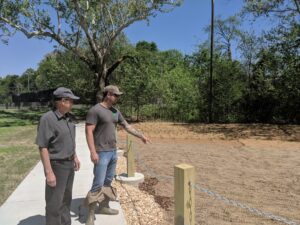 Freshwater Land Trust has completed a habitat restoration project at Roebuck Springs in Don Hawkins Park, in partnership with the City of Birmingham and U.S. Fish and Wildlife Service.
Freshwater Land Trust has completed a habitat restoration project at Roebuck Springs in Don Hawkins Park, in partnership with the City of Birmingham and U.S. Fish and Wildlife Service.
Daniel Drennen from Fish and Wildlife says collaboration among the land trust, USFWS, and cities like Birmingham is vital to improving quality of life for people and ecosystem health for plants and animals.
“Roebuck Springs is an urban oasis, a gem in the middle of an industrial and historical city,” said Drennen. “Our work is assisting the natural spring, which is a unique and precious resource for Birmingham.”
Roebuck Springs is home to the watercress darter, a federally endangered and state protected fish species with only six known habitats in the world, all of which are in Jefferson County. Roebuck Springs is one of six places where the watercress darter is known to live.
Roebuck Springs is one of several natural springs in Jefferson County that provides the cool, clear, flowing water needed for darter species to thrive.
The land trust has enhanced watercress darter habitat at Seven Springs in Birmingham, working closely with members of Faith Apostolic Church, and at Tapawingo Springs in Pinson.
The Roebuck Springs project involved removing asphalt from the parking lot, constructing bioretention areas and bioswales, and adding native plants.
Designed by Goodwyn, Mills and Cawood, these features will slow, filter, and cool runoff water as it flows from the parking lot into the watercress darter’s habitat in the spring.
Speaking of the watercress darter, FLT recently closed on a 26.1-acre conservation easement in the Powderly neighborhood in Birmingham.
The property is home to the watercress darter. FLT was able to secure long-term stewardship funding to help facilitate property management thanks to its partner on the project, Black Warrior Riverkeeper.
Emily Godsey bought this property in 2018, and she then immediately called FLT to start the process of conserving it. She knew it had high conservation value and was a great opportunity to help protect the watercress darter. Now, Godsey has generously donated it as a conservation easement to FLT, which will protect the land from development in perpetuity. Godsey will retain ownership of the property.
“This is how I see part of my legacy,” said Godsey. “I want to make sure this land is protected forever regardless of who holds it. It’s highly important to me to pass it on to my kids and make sure it’s conserved as it moves across generations.”
Godsey comes from a family of long-time conservationists, especially her grandmother, “Bubby,” who shared her love for all things nature with Godsey.FLT’s Land Stewardship Director, Sam McCoy, assessed the property and documented that it contains 228 feet of Seven Springs, the known watercress darter habitat in this area. It also contains over 2,400 feet of two other streams, including Nabors Branch and an unnamed stream that feed into Valley Creek in the Black Warrior River watershed.
“A primary purpose in pursuing this property is so that we could subsequently perform habitat restoration,” said McCoy. “Conserving this property will help reduce future erosion and sedimentation of the waterways and maintain the watercress darter habitat.”
As the holder of the conservation easement, FLT will work closely with Godsey to implement best management practices to potentially include removing invasive vegetation, addressing erosion issues, opening the canopy to allow more sunlight to reach the stream, and assessing a culvert for upstream fish passage.
“This conservation easement is potentially pivotal for the endangered watercress darter,” said Charles Scribner, Executive Director of Black Warrior Riverkeeper. “We are pleased to see yet another one of our pollution lawsuits result in funds going to the Freshwater Land Trust’s great work in this community.”
The stewardship funding for the property management comes from supplemental environmental project (SEP) funding given to FLT after the Black Warrior Riverkeeper’s successful completion of a pollution lawsuit.
Unless otherwise credited, all photos courtesy of FLT. Featured photo shows part of the Turkey Creek team.

